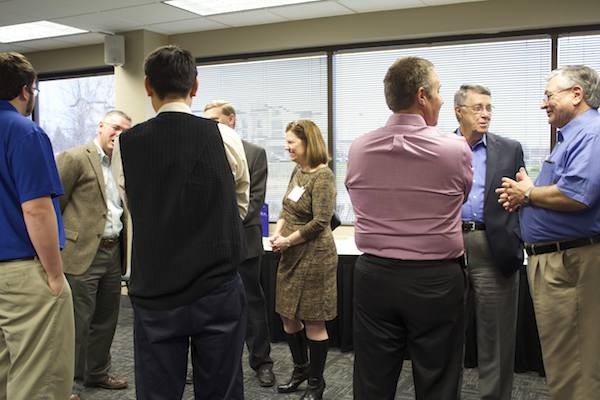
ACerS corporate members gathered near Society headquarters in Columbus, Ohio, last Thursday for invaluable networking, lunching, and learning.
The Society hosted the networking lunch in a continuing effort to meet the needs of its increasing corporate membership.
Megan Bricker, program director of membership at ACerS, welcomed attendees and highlighted some of ACerS other corporate-centric efforts, including the formation of the Society’s new Manufacturing Division and the upcoming inaugural Ceramics Expo, April 28–30, in Cleveland, Ohio.
Pre-lunch chatter amongst attendees provided plenty of time for networking with familiar colleagues, introductions to new connections, and—of course—a little business-card-swapping action.
David McComb, director of the Center for Electron Microscopy and Analysis (CEMAS) at The Ohio State University presented an informal post-lunch talk all about the possibilities for microscopic materials analysis at the state-of-the-art facility.
CEMAS, which opened its doors to academic and non-academic materials investigations just about 18 months ago, hosts a dozen top-line FEI electron microscopes that have the capability to probe failure analysis, quality control, raw material characteristics, and much more.
McComb presented attendees with a slew of real-world examples demonstrating how CEMAS is poised to collaborate with industry to solve even the most difficult materials problems.
McComb made clear the flexibility of the facility by showing how its scanning electron microscopes, transmission electron microscopes, focused ion beam milling, and X-ray diffraction analyses could unravel mysteries in all materials, from metals and ceramics to spinal cords and even toothpaste.
But perhaps the most attractive and unique feature of the facility is its ability for remote access, via incredibly high-speed links, to control the collection of instruments from outside the facility’s walls. For example, McComb says, scientists working at a research facility in a completely different city can collaborate with another scientist in yet another city—all from their respective offices—to investigate one sample being analyzed on the microscope in CEMAS’s facility in Columbus.
The unique combination of expertise, instrumentation, and vision at CEMAS offers unique opportunities for industry partnerships. The center has streamlined its ability to cross over the academic institution lines and reach out to industry by providing flexible collaboration opportunities, including full service analysis and trained user options.
Networking lunches such as this are just one of the many benefits offered to ACerS Corporate Members. Interested in becoming a Corporate Member? We’d love to have you join us!
Author
April Gocha
Spotlight Categories
- Society News
Related Posts
Volunteer spotlight: Hyunjun Kim
December 18, 2025
ACerS GOMD History – A Look Back in Time
December 10, 2025





